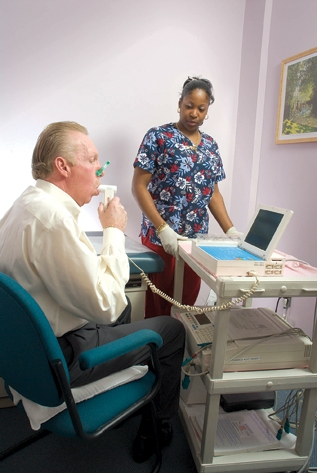How Is COPD Diagnosed?
Your doctor will diagnose COPD based on your signs
and symptoms, your medical and family histories, and test results.
He or she may ask whether you smoke or have had
contact with lung irritants, such as air pollution, chemical fumes, or dust. If
you have an ongoing cough, your doctor may ask how long you've had it, how much
you cough, and how much mucus comes up when you cough. He or she also may ask
whether you have a family history of COPD.
Your doctor will examine you and use a stethoscope
to listen for wheezing or other abnormal chest sounds.
You also may need one or more tests to diagnose
COPD.
Lung Function Tests
Lung
function tests measure how much air you can breathe in and out, how fast
you can breathe air out, and how well your lungs can deliver oxygen to your
blood.
The main test for COPD is spirometry
(spi-ROM-eh-tre). Other lung function tests, such as a lung diffusing capacity
test, also may be used. (For more information, see
"Types of Lung Function Tests.")
Spirometry
During this painless test, a technician will ask you
to take a deep breath in and then blow as hard as you can into a tube connected
to a small machine. The machine is called a spirometer.
The machine measures how much air you breathe out.
It also measures how fast you can blow air out.
Spirometry

The photo shows how spirometry is
done. The patient takes a deep breath and then blows hard into a tube connected
to a spirometer. The spirometer measures the amount of air exhaled and how fast
it was blown out.
Your doctor may have you inhale medicine that helps
open your airways and then blow into the tube again. He or she can then compare
your test results before and after taking the medicine.
Spirometry can detect COPD long before its symptoms
appear. Doctors also may use the results from this test to find out how severe
your COPD is and to help set your treatment goals.
The test results also may help find out whether
another condition, such as
asthma
or heart
failure, is causing your symptoms.
Other Tests
Your doctor may recommend other tests. These tests
include:
- A
chest
x ray or
chest
computed tomography (CT) scan. These tests create pictures of the
structures inside your chest, such as your heart and lungs. The pictures can
show signs of COPD. They also may show whether another condition, such as heart
failure, is causing your symptoms.
- An arterial blood gas test. This blood test
measures the oxygen level in your blood using a sample of blood taken from an
artery. The test can help find out how severe your COPD is and whether you may
need supplemental oxygen therapy.
|

